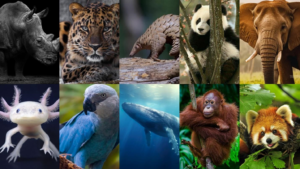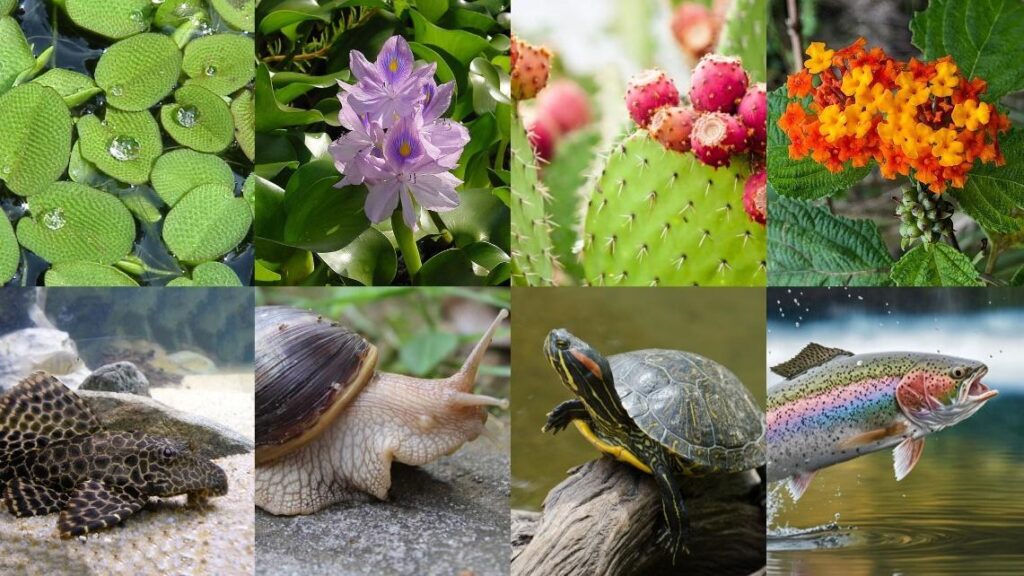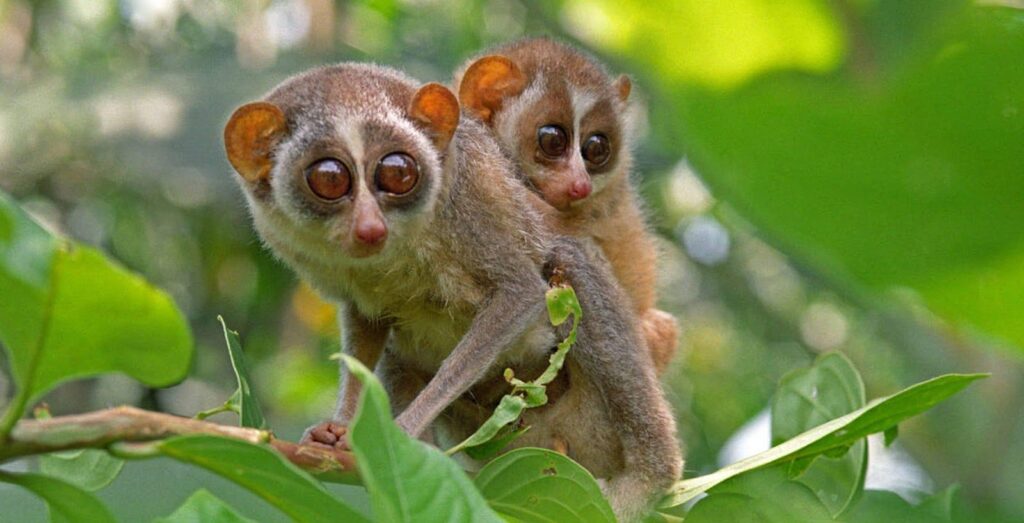Physical Address
23,24,25 & 26, 2nd Floor, Software Technology Park India, Opp: Garware Stadium,MIDC, Chikalthana, Aurangabad, Maharashtra – 431001 India
Physical Address
23,24,25 & 26, 2nd Floor, Software Technology Park India, Opp: Garware Stadium,MIDC, Chikalthana, Aurangabad, Maharashtra – 431001 India

The ecosystem is like a vast web of life where all living organisms interact with each other and their environment. It’s crucial because it provides essential services like clean air, water, pollination, and climate regulation, vital for survival and well-being. Each species plays a unique role in an ecosystem, contributing to its stability and resilience. Accordingly, if there is any challenge to each species for their existence, that will indirectly challenge the strength and resilience of the ecosystem. So, conserving endangered species is critical in a sustainable and eco-friendly world.
World Endangered Species Day is observed to raise awareness about the importance of protecting endangered species and their habitats. It is a day to reflect on the threats facing endangered species, celebrate conservation successes, and promote efforts to conserve biodiversity. Educational programs, habitat restoration projects, and species-specific awareness campaigns are often organized to engage the public in conservation efforts. The day reminds us of our collective responsibility to protect and preserve our planet’s diverse species.
World Endangered Species Day is commemorated on the third Friday of May every year. In 2024, the World Endangered Species Day was on 17th May.

Endangered Species
Endangered species are at risk of extinction due to various factors such as habitat loss, pollution, climate change, and poaching. That means these species are at a higher risk of extinction shortly.
According to the IUCN Red List, more than 44000 species are threatened with extinction, which is 28% of all assessed species. There are nine categories which have categorized species in the IUCN.

Three categories from them represent the endangered species. They are Critically Endangered, Endangered, and Vulnerable Categories.
Here is an article on the world’s rarest/ most endangered species. WWF (World Wildlife Fund) has listed the endangered animals in the world here. This includes,

Biodiversity hotspots are areas where many flora and fauna species are found. These regions are particularly important for conservation efforts because they harbor many species at risk of extinction.
There are 36 areas worldwide that are qualified as biodiversity hotspots. These areas represent 2.5% of the earth’s land surface. Sri Lanka is also a biodiversity hotspot. Despite its relatively small size, Sri Lanka boasts a remarkable variety of flora and fauna, including a number of endemic species found nowhere else on earth.

Endangered Species in Sri Lanka
Sri Lanka is considered a biodiversity hotspot due to its remarkable variety of ecosystems, including rainforests, wetlands, dry forests, and coastal areas. Its isolation as an island, diverse climate, and varied geography contribute to a high level of species endemism, meaning many species are found only in Sri Lanka.
With this higher diversity, some species are endangered for different reasons. Here is the IUCN National Red List in Sri Lanka in 2012. In 2021, the National Red List for Conservation Status of Birds of Sri Lanka was released, and according to the data, Sri Lanka’s birds, especially endemics, are in danger. According to the red list and other data, many flora and fauna species in Sri Lanka, especially endemics, are now in danger.
Here is the list of critically endangered (CR) species in Sri Lanka.
Here is the list of endangered (EN) species in Sri Lanka.
Here is the list of vulnerable (VU) species in Sri Lanka.
Below, there are some highlighting examples of threatened species in Sri Lanka.
Hawksbill Sea Turtle (Eretmochelys imbricata) -CR
Hawksbill turtles can be generally found in tropical sea waters worldwide, primarily in coral reefs where they feed on sponges, jellyfish, and other invertebrates. They are under threat due to habitat destruction, illegal trade of their shells, pollution, accidental capturing from fishing gear, and climate changes.

Purple-Faced Langur (Semnopithecus vetulus) – CR
Purple-faced langurs are endemic old-world monkey species in Sri Lanka. They primarily inhabit tropical rainforests and wet zones. The main threats they face are deforestation, fragmentation of their habitats, and human-wildlife conflict, which generally means habitat loss.

Asian Elephant (Elephas maximus) -EN
Asian elephants inhabit various habitats, including forests, grassland, and agricultural land. However, like many elephant populations across Asia, they face numerous threats, including habitat loss and fragmentation, human-elephant conflict, poaching, and illegal capture. Human-elephant conflict is a significant issue in Sri Lanka, as elephants often come into conflict with farmers when they raid crops or cause property damage.
Conservation efforts in Sri Lanka focus on mitigating human-elephant conflict through electric fencing, wildlife corridors, and community-based approaches. Protected areas and national parks provide essential habitats for elephants and other wildlife. Still, ongoing efforts are needed to ensure the long-term survival of the Asian elephant population in Sri Lanka.

Sri Lanka Leopard (Panthera pardus kotiya) – EN
This subspecies is native to Sri Lanka. They are the island’s top predators and play a crucial role in maintaining the balance of the ecosystem. Sri Lankan leopards have adapted to various habitats, including dry forests, rainforests, and grasslands. The population is estimated to be around 700 to 950 individuals, making them one of the most threatened subspecies.
Conservation efforts in Sri Lanka focus on protecting their habitats, implementing measures to reduce human-leopard conflict, and enforcing laws against poaching and illegal wildlife trade.

Leatherback Sea Turtle (Dermochelys coriacea) – VU
Leatherback turtles are the largest sea turtle species in the world and are known for their unique leathery shell. They are widely distributed worldwide, from tropical to temperate regions. Their population is decreasing rapidly, making them vulnerable to various threats, including habitat destruction, pollution, sea level rise and global warming, and accidental capture by fishing gear.

Many other flora, invertebrates, fishes, amphibians, reptiles, birds, and mammal species are endangered in Sri Lanka. Loris, pangolin, Sri Lankan spotted chevrotain, nelly rat, sloth bear, blue whale (world’s largest mammal), fishing cat, civet, giant squirrel, jungle shrew, Bandula barb, Sri Lanka blue magpie are very few examples of those endangered animals.
Causes of Threatened Species in Sri Lanka
The extinction of species is due to different reasons in Sri Lanka. The biodiversity of Sri Lanka is high due to its climate and geographical factors. But, some changes in these factors and many other reasons lead many endemic and other unique species to be threatened.

Habitat loss often doesn’t occur uniformly but results in fragmented patches of habitat surrounded by areas of unsuitable land (like urban areas or agricultural fields). This fragmentation can isolate populations, making it harder for individuals to find mates. It can also reduce genetic diversity and make populations more vulnerable to environmental change and stochastic events.
Habitats provide essential ecosystem services like pollination, water purification, and carbon sequestration. When habitats are lost, these services are compromised, affecting not just the species that directly depend on the habitat but also other species and even human communities that rely on these services.
As natural habitats shrink, wildlife is forced into closer contact with human settlements. This often leads to conflicts as animals raid crops, damage property, or threaten human safety. In response, humans may kill or drive away wildlife, further exacerbating the threats to the species.
Habitats are home to numerous species, and when habitats are lost, many species lose their homes and are unable to survive elsewhere. This leads to a loss of biodiversity, which can have cascading effects on ecosystem stability and resilience.
Measures such as fencing or clearing land to create buffer zones are often implemented to mitigate human-wildlife conflict. However, these actions can lead to further habitat loss and fragmentation, reducing the available habitat for threatened species and exacerbating their vulnerability.
Human-wildlife conflict can disrupt the natural behavior and movement patterns of threatened species. For example, elephants may alter their migration routes or avoid certain areas due to human presence, changing their foraging patterns and social structure.
Constant exposure to human disturbance, such as noise, lights, or harassment, can stress wildlife and negatively impact their health and reproductive success. Prolonged stress and disturbance can contribute to population declines, particularly in threatened species with small or isolated populations.
Human-wildlife conflict can strain conservation efforts and reduce support for protecting threatened species. When conflicts escalate, communities may become less tolerant of wildlife conservation initiatives, decreasing cooperation and funding for conservation projects.
Poaching often targets specific individuals with desirable or rare traits. This selective pressure can reduce genetic diversity within populations, making them more vulnerable to environmental changes and less resilient to threats such as disease or habitat loss.
In Sri Lanka, turtles (meat and shell), pangolins (for medicine and meat), and elephants (for tusks) are hunted for illegal wildlife trades.

Also, some people using illegal methods for other activities can indirectly harm non-targeted species. For example, in Sri Lanka, fishing gear such as push nets, moxy nets, monofilm nets, and gill nets are prohibited from use in Sri Lankan oceans because they can harm the protected and non-targeted species. But still, some people are continuously using them illegally to get maximum advantage for their economy without thinking about the harm they can cause. Such illegal activities are also a threat to many species in Sri Lanka.
Here to read more about poaching and illegal wildlife trade.

Water pollution from industrial effluents, agricultural runoff, and domestic waste contaminates water bodies, affecting aquatic species such as fish, amphibians, and turtles. High levels of pollutants can lead to habitat degradation, reduced water quality, and direct toxicity to aquatic organisms, resulting in population declines and local extinctions.
Sri Lanka’s coastal waters are polluted by plastic debris, oil spills, and chemical contaminants. Marine pollution impacts marine species such as corals, fish, marine mammals, and sea turtles, affecting their health, reproduction, and habitat availability. For example, marine turtles’ ingestion of plastic debris can cause blockages in their digestive systems, leading to starvation and death.
Urbanization, industrial activities, and vehicular emissions contribute to air pollution in Sri Lanka, affecting both terrestrial and aquatic species. Airborne pollutants can deposit onto land and water surfaces, contaminating soil, water, and food sources for wildlife. Exposure to air pollution can compromise species’ health and reproductive success, contributing to population declines.
Pollution can degrade habitats and alter ecosystem dynamics, making them less suitable for species’ survival. For example, soil pollution from agricultural chemicals or industrial pollutants can reduce soil fertility and disrupt nutrient cycling, affecting plant growth and biodiversity. This, in turn, can impact species that rely on these habitats for food and shelter.
Some pollutants, such as heavy metals and persistent organic pollutants, can accumulate in the tissues of organisms through the food chain. This process, known as bioaccumulation, can result in high concentrations of contaminants in top predators, leading to health and reproductive problems. Biomagnification occurs when pollutants become more concentrated at higher trophic levels, increasing the risk to species at the top of the food chain.
Climate change can disrupt ecosystem dynamics and species interactions. For example, changes in temperature and rainfall patterns can affect the timing of seasonal events such as flowering, migration, and reproduction, leading to mismatches between species’ life cycles. This can disrupt food webs and lead to declines in species that rely on specific resources or timing cues.
Rising temperatures and changing climatic conditions can cause species’ geographic ranges to shift as they search for suitable habitats. Species unable to adapt or migrate may face increased competition, predation, or loss of resources, leading to population decline and, ultimately, extinction.
Climate change is associated with increased frequency and intensity of extreme weather events such as heatwaves, droughts, floods, and cyclones. These events can directly impact species by causing mortality, habitat destruction, or displacement. Species already threatened or restricted ranges may be particularly vulnerable to these extreme events.
Increased atmospheric carbon dioxide levels result in ocean acidification, negatively impacting marine species such as corals, shellfish, and plankton. Ocean acidification and rising sea temperatures can lead to coral bleaching events, where corals expel their symbiotic algae and become more susceptible to disease and mortality. Coral reefs provide essential habitat for numerous species, and their decline can have cascading effects on marine ecosystems.
Climate change can impact the reproduction of some species. For example, turtles lay their eggs in sand pits on the shore. The temperature of the sand and the environment can decide the sexuality of the new-born. This also affects their population growth rate and can threaten the population size and reproduction rate.

They are a reason for leading some native species into danger.
Invasive species often outcompete native species for resources such as food, water, and habitat. This can lead to a decline in native populations as they struggle to survive.
Some invasive species may prey on native species, reducing their population sizes and potentially driving them to extinction.
Invasive species can introduce new diseases to native species that they may not have defenses against, leading to widespread illness and mortality.
Invasive species can alter the habitat in ways detrimental to native species, such as changing vegetation structure or modifying the physical environment.
Interbreeding between invasive and native species can lead to genetic pollution and the loss of unique genetic traits in native populations.
Here to read more on how invasive species affect biodiversity.
Many of these situations can occur with human intervention. They conduct deforestation, hunting, urbanization, pollution, and even the spreading of invasive species, which can happen with humans’ mediation. So, more of these threats can be decreased by changing some harmful human activities.
Endangered Species Conservation in Sri Lanka
Many government and non-government organizations in Sri Lanka work to conserve flora and fauna species. These parties, along with the other communities in Sri Lanka, are taking many actions to preserve endangered species.
Endangered species conservation in Sri Lanka involves various efforts to protect and preserve the country’s vulnerable plant and animal species. Some key conservation strategies include,
To educate further about related topics and make experts in the relevant field, universities and other higher education institutions carry degrees, diplomas, and other related programs.
With the country’s infrastructure development, many development projects are happening. Conducting these projects sustainably with minimum harm to the ecosystem and species is important. For that research, sustainable planning and environmental record-making are essential. Also, it is crucial to shape the development plans to be more sustainable and eco-friendly and continue them in the recommended quality and requirements to minimize damage.

By implementing these strategies and fostering collaboration among various stakeholders, Sri Lanka can work towards safeguarding its unique biodiversity and ensuring the survival of its endangered species for future generations.-With inputs from Mihiri Saparamadhu–
Comments are closed.
Lạc vào trong nền tảng yo88.com đáng tin cậy, được phát triển dành riêng cho những người hâm mộ sòng bạc nồng nhiệt.